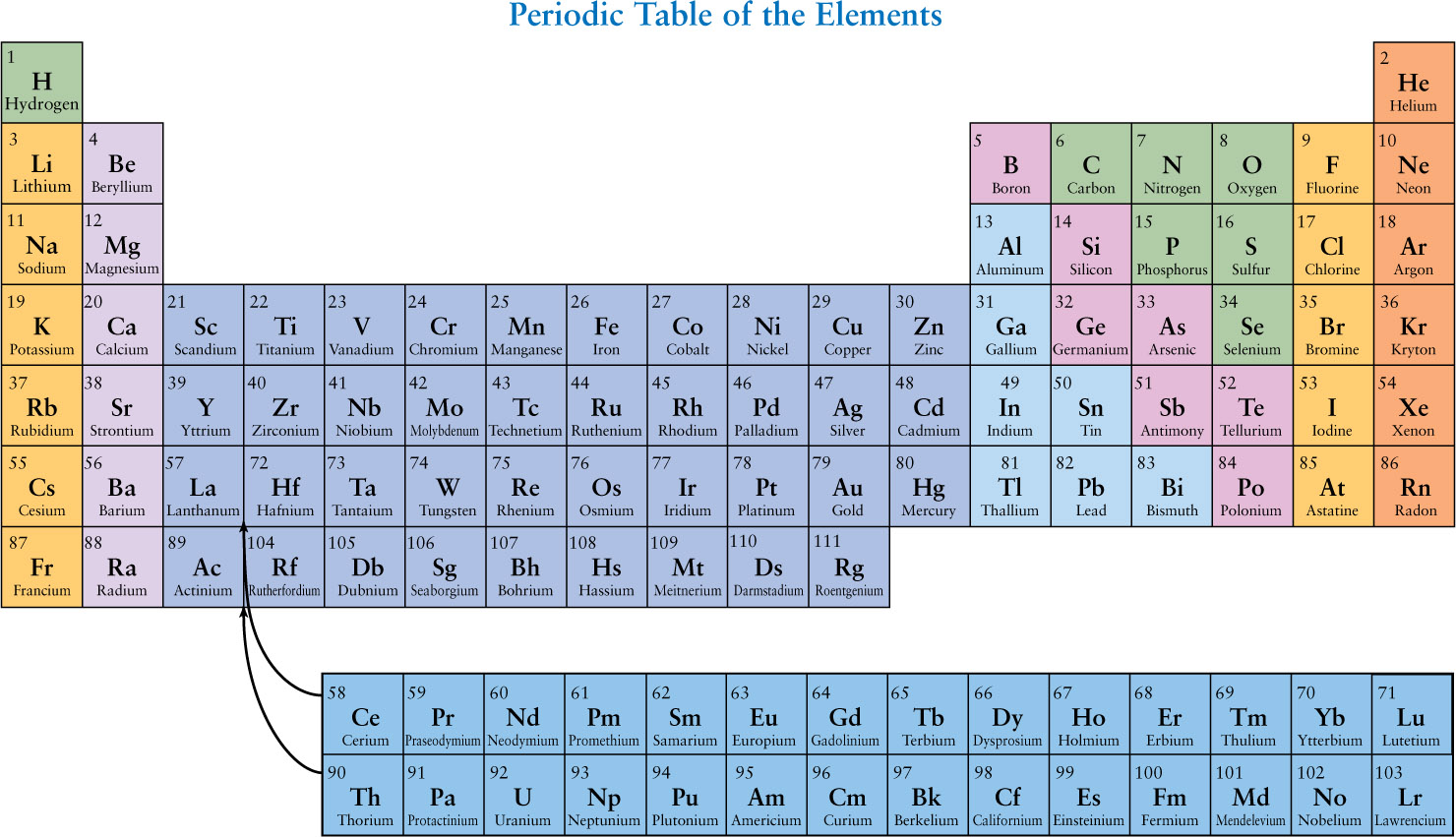BOX 5-5 TOOLS OF THE ASTRONOMER’S TRADE
Atoms, the Periodic Table, and Isotopes
Each different chemical element is made of a specific type of atom. Each specific atom has a characteristic number of protons in its nucleus. For example, a hydrogen atom has 1 proton in its nucleus, an oxygen atom has 8 protons in its nucleus, and so on.
The number of protons in an atom’s nucleus is the atomic number for that particular element. The chemical elements are most conveniently listed in the form of a periodic table (shown in the figure). Elements are arranged in the periodic table in order of increasing atomic number. With only a few exceptions, this sequence also corresponds to increasing average mass of the atoms of the elements. Thus, hydrogen (symbol H), with atomic number 1, is the lightest element. Iron (symbol Fe) has atomic number 26 and is a relatively heavy element.
All the elements listed in a single vertical column of the periodic table have similar chemical properties. For example, the elements in the far right column are all gases under the conditions of temperature and pressure found at Earth’s surface, and they are all very reluctant to react chemically with other elements.
In addition to nearly 100 naturally occurring elements, the periodic table includes a number of artificially produced elements. Most of these elements are heavier than uranium (symbol U) and are highly radioactive, which means that they decay into lighter elements within a short time of being created in laboratory experiments. Scientists have succeeded in creating only a few atoms of elements 104 and above.
The number of protons in the nucleus of an atom determines which element that atom is. Nevertheless, the same element may have different numbers of neutrons in its nucleus. For example, oxygen (O) has atomic number 8, so every oxygen nucleus has exactly 8 protons. But oxygen nuclei can have 8, 9, or 10 neutrons. These three slightly different kinds of oxygen are called isotopes. The isotope with 8 neutrons is by far the most abundant variety. It is written as 16O, or oxygen-16. The rarer isotopes with 9 and 10 neutrons are designated as 17O and 18O, respectively.
The superscript that precedes the chemical symbol for an element equals the total number of protons and neutrons in a nucleus of that particular isotope. For example, a nucleus of the most common isotope of iron, 56Fe or iron-56, contains a total of 56 protons and neutrons. From the periodic table, the atomic number of iron is 26, so every iron atom has 26 protons in its nucleus. Therefore, the number of neutrons in an iron-56 nucleus is 56 − 26 = 30. (Most nuclei have more neutrons than protons, especially in the case of the heaviest elements.)
It is extremely difficult to distinguish chemically between the various isotopes of a particular element. Ordinary chemical reactions involve only the electrons that orbit the atom, never the neutrons buried in its nucleus. But there are small differences in the wavelengths of the spectral lines for different isotopes of the same element. For example, the spectral line wavelengths of the hydrogen isotope 2H are about 0.03% greater than the wavelengths for the most common hydrogen isotope, 1H. Thus, different isotopes can be distinguished by careful spectroscopic analysis.
Isotopes are important in astronomy for a variety of reasons. By measuring the relative amounts of different isotopes of a given element in a Moon rock or meteorite, the age of that sample can be determined. The mixture of isotopes left behind when a star explodes into a supernova (see Section 1-3) tells astronomers about the processes that led to the explosion. And knowing the properties of different isotopes of hydrogen and helium is crucial to understanding the nuclear reactions that make the Sun shine. Look for these and other applications of the idea of isotopes in later chapters.
